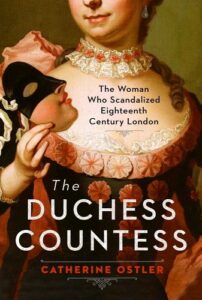[ad_1]
In April 1776, the world held its breath.
The determination of George Washington’s band of American revolutionaries was being tested as they prepared for battle to defend New York: would they cede to the British yoke or strike out for independence and unleash the dominance, for the coming centuries, of what was to become the United States of America?

These decisive days were the last time that George III, the Hanoverian British king, could have conceivably held on to his American empire. The British peace commissioner, Admiral Howe, still hoped “words rather than bullets” might solve the crisis when he arrived on Long Island.
Yet in London, the drama was—incredibly—elsewhere. Among the House of Lords, the judiciary, the press, and the literati, all eyes were on a woman in black, charged with bigamy.
The trial saw the queen, two future kings, Queen Victoria’s father, Georgiana, Duchess of Devonshire, James Boswell, Horace Walpole, and most of the bishops, peers, and peeresses in the land in Westminster Hall, either as jury or spectator. Half of the Cabinet was there, the secretary of war a witness.
The woman accused was christened Elizabeth Chudleigh, but when she was talked about in the coffeehouses, written about in the penny papers, gossiped about by diarists, and sketched by cartoonists, they more often nicknamed her the Duchess-Countess.
Now we see it more clearly: the distracted incompetence of a tired colonial power engaged in the displacement activity of persecuting an errant, aristocratic woman. But the story of the Duchess-Countess casts other, more human, shafts of light onto this period of history, in which the seeds of so much of our culture were sown: the struggle of a forward-thinking woman in a society undergoing the birth pangs of modernity; the rise of journalism, an incipient always-on form of social media, and its occasionally willing collaborator, the celebrity; the way in which Elizabeth used soft power and the art of public relations, before either had those names.
The Georgian patriarchy had law, land, money, and church on their side: alternative forms of influence had to be found for a woman who wanted to travel, build, and mix as if she were man or monarch. Duchess, countess, courtier, socialite, hostess, mariner, property developer, celebrity, vodka distiller, press manipulator, arts patron, bigamist: Elizabeth Chudleigh was the great antiheroine of the Georgian era. Her story reads like a dark fairy tale, Cinderella gone hideously, publicly wrong with all the force of a Hogarthian twist, with too many princes and glass slippers left smashed in her wake. The Hon. Elizabeth Chudleigh, Elizabeth Hervey, Duchess of Kingston, Countess of Bristol—by the time she went on trial, no one knew what to call her—started her life in the public sphere as a maid of honour to the Princess of Wales at the Georgian court, married one man in secret and denied it, only to wed another. She was convicted of bigamy and then pursued across the world by her second husband’s relations, the newspapers, and the ill-wishes of her enemies. After her court humiliation, rather than choosing to live out the rest of her days in hermetic retirement or atonement, she went on a floating odyssey from Rome to St. Petersburg, befriending popes, princes, and tsarinas. She became one of the three most talked-about women in Europe, alongside Marie Antoinette and Catherine the Great. The Hermitage in St. Petersburg still possesses the paintings and the giant but delicate musical chandelier she took there to persuade the court to embrace her, taking advantage of the vibrant Anglomania that gripped Imperial Russia at the time.
Tracing the story from her childhood at the Royal Hospital in Chelsea, to rural Devon, the London court, the grandeur of the Dukeries and, later, France and Russia, one encounters the Hanoverian world in all its elegance and acidity, but also the tale of a woman bridling against history. In her publicity-hungry, wanderlustful, outrageously under- or overdressed self, Elizabeth Chudleigh was an anarchic woman, out of step with her own time.
Given her notoriety, it is not surprising that numerous writers were fascinated by her. The twists and turns of her progress, the whole cautionary tale, lived on after her death. Decades later, Thackeray drew on Elizabeth for inspiration in his fiction—for calculating yet irresistible Becky Sharp in Vanity Fair, chilly beauty Beatrix Esmond in Esmond, rackety much-married Baroness Bernstein in the sequel The Virginians, and the bigamous Blanche Clavering in Pendennis.
Dickens’s Household Words and Virginia Woolf’s essays both contain anecdotes from her life. Coleridge, bewailing his own faux naivety in a letter to Wordsworth, described himself as resembling “the Duchess of Kingston, who masqueraded in the character of ‘Eve before the Fall’ in flesh-coloured Silk.” She even inspired a hoax novel—I, Libertine—on American radio in the 1950s.*
Accounts of her life, her trial, even her will were published within days of her death. In a merging of fact and fiction, she was damned by the popular press as a grotesque, sexually heartless, with a lust for diamonds; objectified as that sexist cliché, the aging femme fatale. In death, as in life, the bile and condemnation continued.
The purpose of biography is to understand rather than justify, but it is impossible to ignore the fact that Elizabeth was put on trial all over again after her death by her startlingly unsympathetic early biographers. She was obviously flawed and complex—by turns brave, reckless, insecure, loving, greedy, resilient, depressive—a woman totally unwilling to accept the female status of underdog or to hand over all the power, the glory, and the adventures of life to men.
My intention is not to exonerate Elizabeth, but to retread the path of her life, and re-examine her trajectory in the context of her era, and thereby take her out of caricature and back to womanhood. To reappraise a woman who became that contemporary phenomenon: the criticized celebrity, loathed and envied in an age when women were seen through the filter of a misogynistic culture, noted for virtue or lack of it. To restore her as a woman with the burden of tragedy and great loss; with the pressure of secrets; who fell in love, but made a mistake; who showed physical endurance and personal courage at the courts of Europe. A woman who could show herself to be trusting, generous, forgiving, although she was a restless soul, impulsive, hotheaded, and her overwhelming priority was her own survival at any cost.
From her birth in the fractious early years of the Hanoverian ascent, in the aftermath of the South Sea Bubble, to her trial as America rebelled and her death in exile in Paris among the sounds of fireworks, the first stirrings of the French Revolution, her life provides an insight into her seismic age. She became an early European; one of the first women to travel and settle in various corners of the world by necessity, but also by instinct and inclination.
During that period, many of our habits—news, novels, gossip, fashion, coffee, consumerism—took hold. War overturned the world order: Russia became a superpower, the Jacobite threat was extinguished, and although America was lost, the battle for the British Empire was increasingly won. In romantic matters there was one rule for men—including a succession of promiscuous kings and prime ministers—and another for women. As marriage changed from a matter of the head to a matter for the heart, the shift bred much confusion along the way.
Through a contemporary lens, many of the issues that surround Elizabeth would be well understood: a struggle with mental health, for female empowerment, for civilized divorce laws, the cost of fame-seeking. Annual sales of British newspapers had risen from 2.5 million in 1713 to 12.6 million in 1775,5 the year before her trial, and as a fashionable woman connected to royalty, accused of a crime, she could not have been a better subject. But she toyed with publications herself like any controlling celebrity today, paying numerous publicists, lawyers, and editors to defend her. Her story was read in coffee shops and drawing rooms from St. Petersburg to Rome.
Elizabeth used her beauty, wit, and connections to further her own position. She tried to remove the obstacles in a woman’s way: the lack of income, the lack of male relatives, the entrapment of an unwise marriage. For women of Elizabeth’s ilk, born into gentry but not well-off, the only respectable salvation, bar a convent or becoming a governess—and Elizabeth was palpably unsuited to both—was marriage. Women were dollhouse figures, expected to lead small, decorative, confined lives traipsing in a carriage between town and country, drawing room and ballroom. Elizabeth Chudleigh shamelessly disregarded both the role and its constraints.
Piecing her story together is an imprecise enterprise. Even while she lived, fiction gnawed on truth. Thousands of words were written about her trial, yet it lacked clarity and fairness; cross-examination was somewhat random, palpable corruption and witness inconsistencies ignored. However, it does expose the female plight then, that even someone as privileged and well-connected as Elizabeth was condemned to remain in her first unhappy marriage by the law and by an unforgiving society.
In the eighteenth-century oligarchy, the lack of social mobility, the reliance on inheritance, and the status that came with it snared those hoping for legacies into endless legal quests. Those with no prospects were left hopelessly insecure. Most particularly, women, who could so easily (like some associates of Elizabeth’s) become destitute. Downward social mobility was easy—the Duchess-Countess was no stranger to the pawnshop. Women of all classes looked to men for support.
If the Kingston case served to expose anything, it was the trap in which eighteenth-century women were placed. Elizabeth was the manifestation of women’s humiliating, claustrophobic lack of autonomy and their lack of independence.
In this, she was just like America.
___________________________________
Excerpted from The Duchess Countess: The Woman Who Scandalized 18th Century London, by Catherine Ostler. Published by Atria Books. Copyright 2022, Catherine Ostler. All rights reserved. Reprinted with permission

___________________________________
* It became a real novel, I, Libertine, by the imaginary author Frederick R. Ewing (in reality, Theodore Sturgeon), after broadcaster Jean Shepherd’s radio hoax on the bestseller lists. His listeners went into bookshops and ordered the nonexistent title, propelling it onto the bestseller lists. As a result, the actual book—a bodice-ripping yarn about an eighteenth-century roué, based on Elizabeth’s life—was written.
[ad_2]






